Yoga offers significant benefits for flexibility, strength, and mental clarity. Different styles, such as Hatha and Vinyasa, enhance physical abilities and focus. Specific practices can boost effectiveness, while modifications ensure accessibility for all skill levels. Community support further enriches the yoga experience, fostering motivation and personal growth.
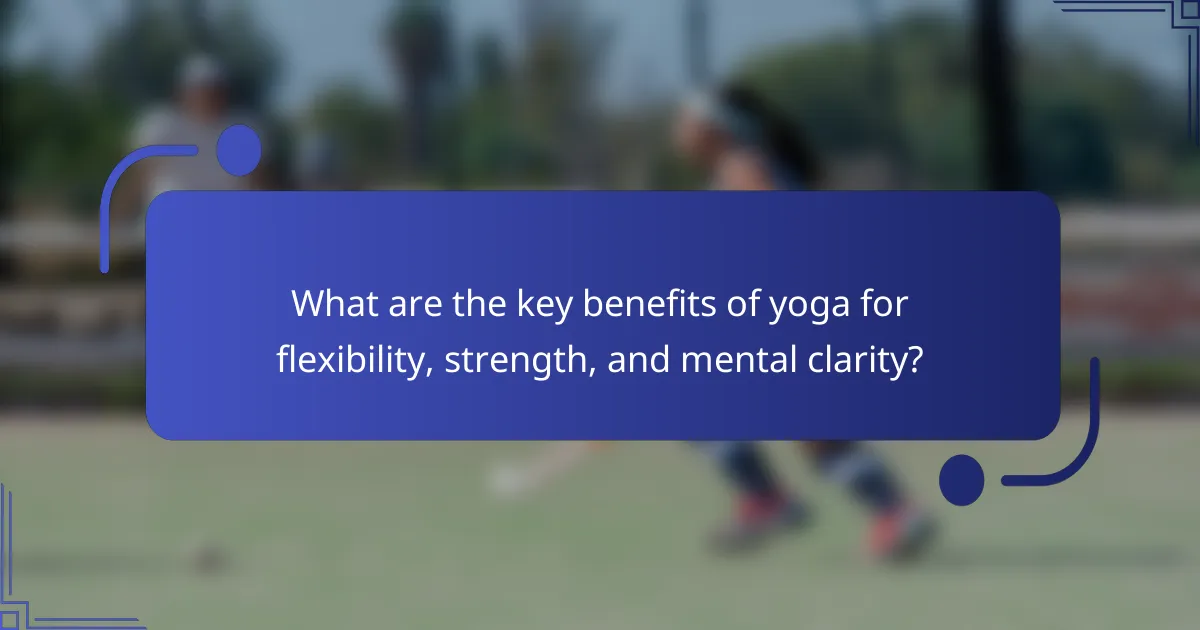
What are the key benefits of yoga for flexibility, strength, and mental clarity?
Yoga enhances flexibility, strength, and mental clarity through various practices. Regular yoga sessions improve muscle elasticity, boosting overall flexibility. Strength is developed through resistance against body weight, leading to toned muscles. Mental clarity arises from mindfulness techniques, reducing stress and enhancing focus. These combined benefits contribute to a balanced and healthy lifestyle.
How does yoga enhance physical flexibility?
Yoga significantly enhances physical flexibility through a combination of stretching, strengthening, and mindful breathing. Regular practice involves various poses that target different muscle groups, promoting increased range of motion. For example, poses like Downward Dog and Cobra stretch the spine and hamstrings, improving overall flexibility. As a result, practitioners often experience reduced muscle tension and enhanced mobility over time. Additionally, the mental focus required during yoga sessions encourages body awareness, further supporting physical flexibility development.
Which yoga poses are most effective for building strength?
The most effective yoga poses for building strength include Downward Dog, Plank, Warrior II, and Chair Pose. These poses engage multiple muscle groups, enhancing overall strength and stability.
Downward Dog strengthens the arms, shoulders, and core. Plank focuses on core stability and builds endurance in the arms and legs. Warrior II enhances leg strength and balance, while Chair Pose targets the thighs and glutes. Incorporating these poses into your routine can significantly improve physical strength.
What role does yoga play in improving mental clarity?
Yoga significantly enhances mental clarity through focused breathing and mindfulness practices. These techniques reduce stress, improve concentration, and promote emotional balance. Research indicates that regular yoga practice can lead to increased cognitive function and better decision-making. By integrating physical postures with mental focus, yoga cultivates a state of awareness that sharpens clarity and enhances overall mental performance.
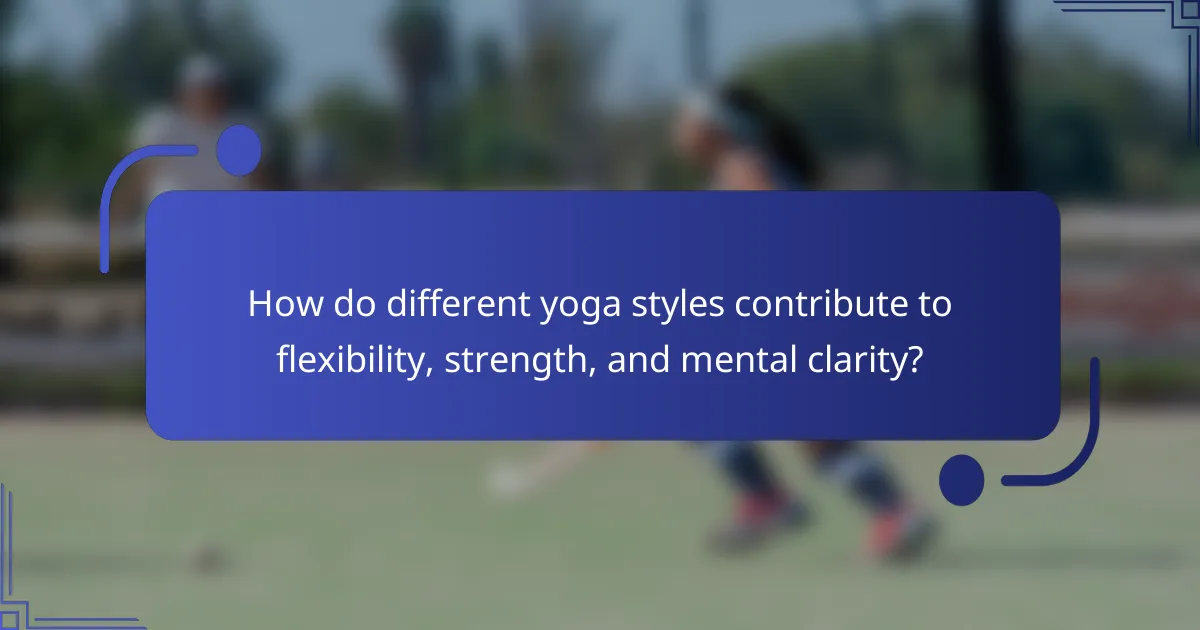
How do different yoga styles contribute to flexibility, strength, and mental clarity?
Different yoga styles enhance flexibility, strength, and mental clarity through varied techniques and postures. Hatha yoga focuses on foundational postures, improving flexibility and strength. Vinyasa emphasizes flow and coordination, enhancing both physical endurance and mental focus. Ashtanga offers a rigorous sequence that builds strength and discipline, while Yin yoga targets deep connective tissues, promoting flexibility and relaxation. Each style uniquely contributes to an overall sense of mental clarity, fostering mindfulness and stress reduction.
What are the unique characteristics of Hatha yoga in achieving these goals?
Hatha yoga uniquely enhances flexibility, strength, and mental clarity through its focus on postures, breath control, and meditation. The practice emphasizes alignment and balance, fostering physical strength while promoting relaxation. Additionally, Hatha yoga incorporates various breathing techniques that improve lung capacity and mental focus. Regular practice can lead to increased body awareness and emotional stability, making it effective for holistic well-being.
How does Vinyasa yoga facilitate strength and flexibility?
Vinyasa yoga enhances strength and flexibility through dynamic movements and breath synchronization. This practice engages various muscle groups, promoting strength while facilitating a full range of motion. The continuous flow of postures builds endurance and improves flexibility over time, leading to increased overall physical capability. Additionally, Vinyasa yoga fosters mental clarity by encouraging mindfulness and focus during transitions, creating a holistic approach to physical and mental well-being.
In what ways does Kundalini yoga promote mental clarity?
Kundalini yoga promotes mental clarity through breath control, meditation, and specific postures. These practices enhance focus, reduce stress, and improve cognitive function. Regular sessions stimulate the nervous system, fostering a sense of awareness and presence. As a result, practitioners often experience heightened intuition and clearer thinking.
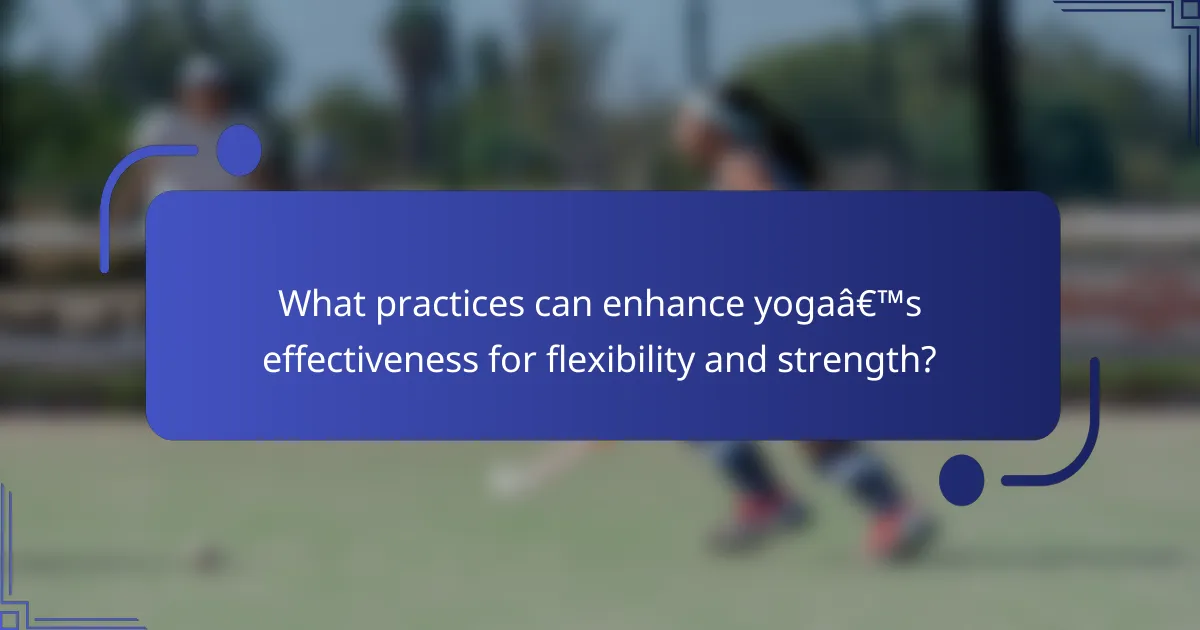
What practices can enhance yoga’s effectiveness for flexibility and strength?
Incorporating specific practices can significantly enhance yoga’s effectiveness for flexibility and strength. Focus on dynamic stretching, which prepares muscles for deeper poses. Incorporate strength-building postures like plank and warrior to develop core stability. Utilize breath control techniques to improve focus and deepen stretches. Regularly practicing restorative yoga can also aid recovery and enhance overall flexibility.
Which breathing techniques support improved flexibility and strength?
Breathing techniques such as diaphragmatic breathing, Ujjayi breath, and Nadi Shodhana enhance flexibility and strength in yoga. Diaphragmatic breathing promotes deep lung capacity, improving oxygen flow. Ujjayi breath generates internal heat, aiding muscle flexibility. Nadi Shodhana balances energy channels, enhancing focus and strength during practice.
How does mindfulness in yoga contribute to mental clarity?
Mindfulness in yoga enhances mental clarity by promoting focus and reducing distractions. Practicing mindfulness during yoga encourages individuals to concentrate on their breath and body movements, fostering a deeper connection to the present moment. This heightened awareness can lead to improved cognitive function and better decision-making. Studies show that regular mindfulness practice can reduce stress and anxiety, which often cloud mental clarity. As a result, individuals may experience clearer thinking and enhanced problem-solving abilities, making mindfulness a valuable aspect of yoga practices aimed at mental clarity.
What is the importance of a balanced diet in supporting yoga practice?
A balanced diet is crucial for enhancing yoga practice by providing essential nutrients that support flexibility, strength, and mental clarity. Proper nutrition fuels the body, enabling optimal performance during yoga sessions. It helps maintain energy levels, aids recovery, and promotes overall well-being. Additionally, specific nutrients, such as omega-3 fatty acids and antioxidants, can reduce inflammation and improve cognitive function, directly benefiting yoga practitioners.
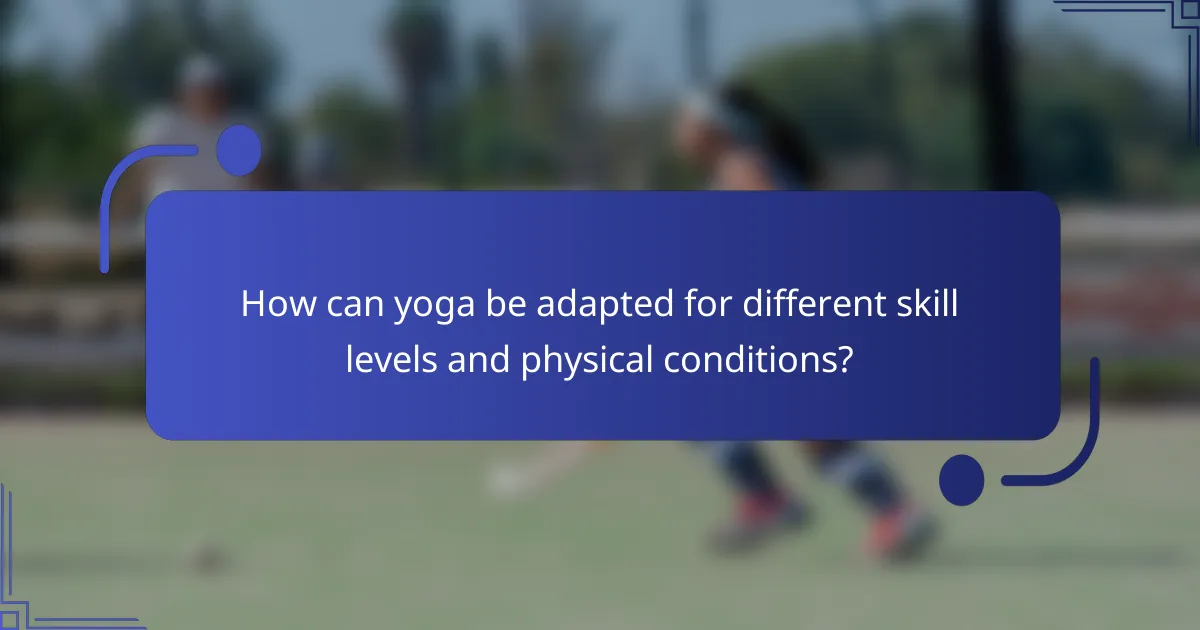
How can yoga be adapted for different skill levels and physical conditions?
Yoga can be adapted for various skill levels and physical conditions through modifications and personalized approaches. Beginners can start with gentle poses and focus on breath control, while advanced practitioners can explore challenging variations.
For individuals with physical limitations, props like blocks and straps provide support, enhancing accessibility. Chair yoga is an excellent option for those with mobility issues, allowing participation without strain.
In addition, classes can be tailored to specific needs, such as restorative yoga for stress relief or power yoga for strength building. This adaptability ensures that everyone can benefit from yoga’s physical and mental clarity enhancements.
What modifications can beginners make to enhance their practice?
Beginners can enhance their yoga practice by incorporating modifications that promote safety and effectiveness. Focus on using props like blocks and straps to support poses. Adjusting the range of motion can prevent strain while improving flexibility. Practicing with a slower pace helps in building strength and mental clarity. Listening to your body and allowing for rest days fosters a sustainable practice.
How can advanced practitioners deepen their flexibility and strength?
Advanced practitioners can deepen their flexibility and strength through targeted yoga practices. Incorporating dynamic movements, such as vinyasa flows and advanced asanas, enhances muscle engagement and flexibility. Focusing on breath control during these practices improves mental clarity and connection to the body. Regularly integrating strength-building poses, such as arm balances and inversions, also contributes to overall physical stability. Engaging in restorative practices, like yin yoga, allows for recovery and deeper stretching, promoting long-term flexibility gains.
Which considerations should individuals with injuries keep in mind?
Individuals with injuries should prioritize safety, listen to their bodies, and consult professionals. Modifications and gentle practices are essential for recovery. Focus on alignment to prevent strain and enhance healing. Gradually increase intensity and duration to avoid setbacks.
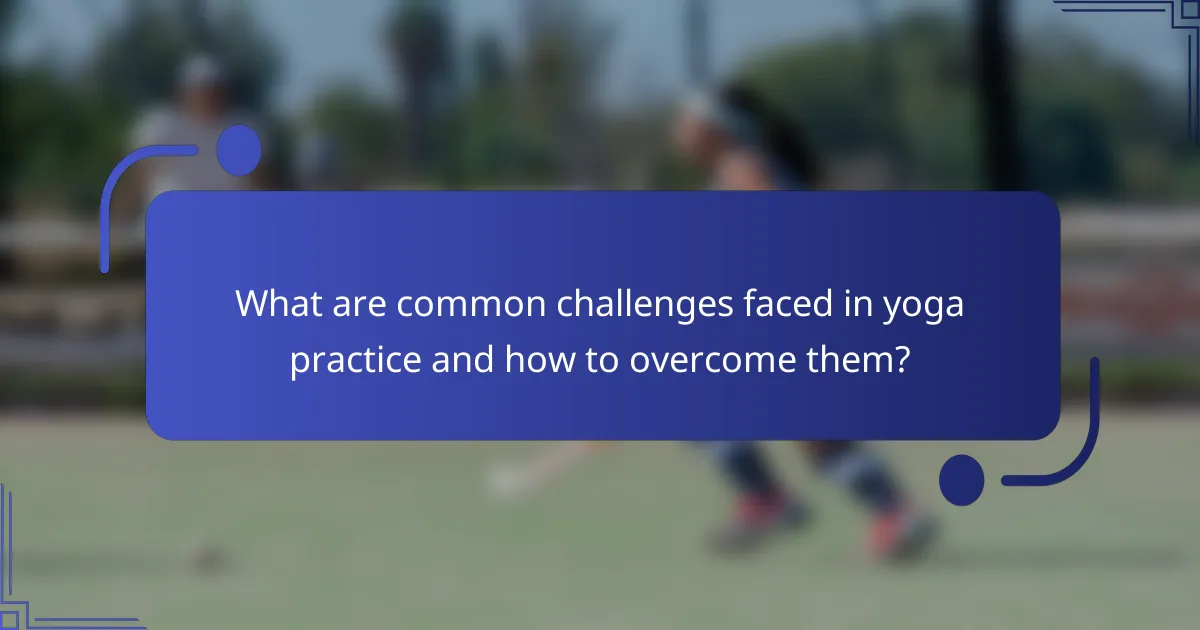
What are common challenges faced in yoga practice and how to overcome them?
Common challenges in yoga practice include physical limitations, distractions, and mental blocks. To overcome these, focus on gradual progress, create a dedicated space for practice, and incorporate mindfulness techniques.
Physical limitations can hinder flexibility and strength. Address this by starting with modified poses and gradually increasing intensity. Distractions can disrupt concentration; establishing a quiet, clutter-free environment enhances focus. Mental blocks may arise from self-doubt or anxiety; practicing meditation alongside yoga can improve mental clarity and confidence.
Engaging in regular practice fosters resilience against these challenges, ultimately promoting a deeper connection to yoga’s benefits.
How can practitioners deal with frustration in achieving flexibility?
Practitioners can manage frustration in achieving flexibility through consistent practice, mindfulness, and setting realistic goals. Emphasizing patience allows individuals to recognize their progress over time. Incorporating breathwork enhances focus and reduces anxiety, fostering a supportive mental environment. Additionally, varying yoga styles can prevent monotony and encourage exploration, ultimately leading to greater flexibility and strength.
What strategies help in building strength through consistent practice?
Consistent yoga practice builds strength through focused poses and intentional breathing. Incorporating foundational postures like Downward Dog and Warrior II enhances muscle engagement and stability. Regular practice fosters mental clarity, allowing practitioners to connect mind and body effectively. As a result, individuals develop resilience and improved physical performance over time.
How can one maintain focus and mental clarity during practice?
To maintain focus and mental clarity during practice, incorporate mindfulness techniques, controlled breathing, and consistent routines. Mindfulness enhances awareness, helping practitioners stay present. Controlled breathing regulates energy and calmness, while a consistent routine fosters discipline and focus. These elements collectively support mental clarity in yoga.
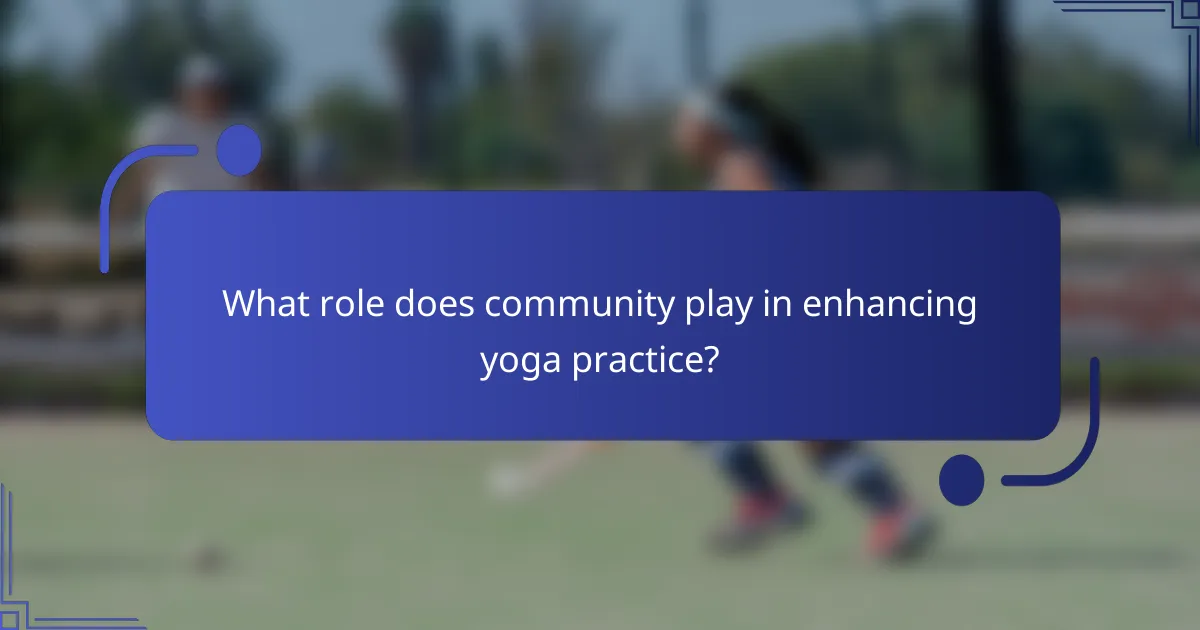
What role does community play in enhancing yoga practice?
Community significantly enhances yoga practice by fostering support, motivation, and accountability. Practicing in a group setting encourages individuals to push their limits, leading to improved flexibility, strength, and mental clarity. Social interactions during classes create a sense of belonging, which can boost mental well-being. Additionally, sharing experiences and challenges within a community can lead to deeper insights and personal growth, enhancing overall practice. Regular group sessions may also introduce diverse techniques and perspectives, enriching the yoga experience.
How do group classes influence motivation and commitment?
Group classes significantly enhance motivation and commitment in yoga practices. The communal environment fosters accountability and support among participants. This social aspect encourages consistent attendance and engagement, leading to improved flexibility, strength, and mental clarity.
Shared experiences during classes create a sense of belonging, motivating individuals to push their limits. Studies show that group settings can increase adherence to exercise routines by up to 30%. Additionally, instructors can provide personalized feedback, enhancing individual progress and commitment to practice.
The unique attribute of group classes lies in the energy generated by collective participation, which can inspire individuals to achieve their personal goals. As a result, participants often report higher satisfaction and improved mental well-being, reinforcing their commitment to yoga.
What benefits do online yoga communities offer?
Online yoga communities offer support, motivation, and access to diverse practices. Participants can share experiences, receive guidance, and connect with like-minded individuals. These communities enhance mental clarity through shared mindfulness practices and foster strength and flexibility through varied class offerings. As a result, members often experience improved overall well-being and a sense of belonging.
How can local workshops enhance personal growth in yoga?
Local workshops enhance personal growth in yoga by providing hands-on guidance, community support, and personalized feedback. Participants gain flexibility, strength, and mental clarity through interactive sessions tailored to their needs. Workshops often feature experienced instructors who offer unique insights, fostering deeper understanding and practice. Engaging with others in a supportive environment encourages motivation and accountability, amplifying individual growth.
What are best practices for maximizing the benefits of yoga for flexibility, strength, and mental clarity?
To maximize the benefits of yoga for flexibility, strength, and mental clarity, practice consistently, focus on breath control, and incorporate a variety of poses.
Engage in daily sessions, aiming for at least 30 minutes. This consistency enhances muscle elasticity and builds strength over time. Prioritize poses like Downward Dog and Warrior II, which target multiple muscle groups.
Incorporate pranayama techniques to improve mental clarity. Breathing exercises, such as Nadi Shodhana, foster concentration and reduce stress.
Consider guided sessions or classes to ensure proper form and technique. Expert instruction can optimize your practice, ensuring you gain maximum benefits from each session.


